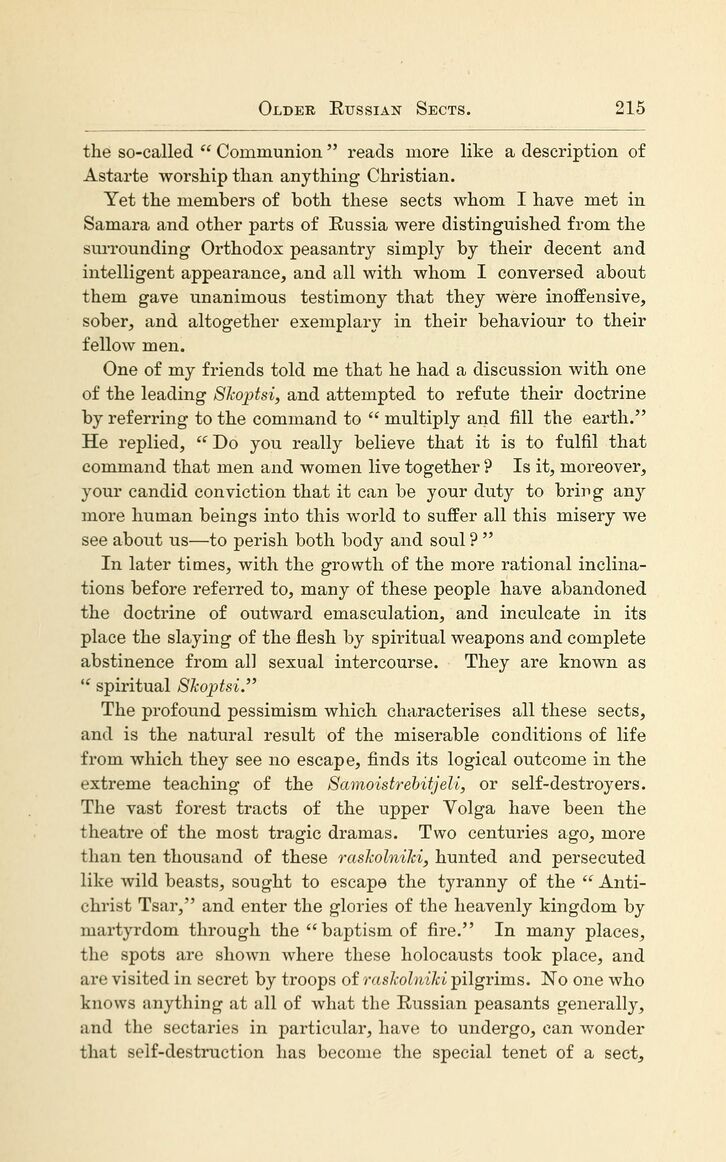
Full resolution (JPEG) - On this page / på denna sida - XIV. Older Russian Sects

<< prev. page << föreg. sida << >> nästa sida >> next page >>
Below is the raw OCR text
from the above scanned image.
Do you see an error? Proofread the page now!
Här nedan syns maskintolkade texten från faksimilbilden ovan.
Ser du något fel? Korrekturläs sidan nu!
This page has been proofread at least once.
(diff)
(history)
Denna sida har korrekturlästs minst en gång.
(skillnad)
(historik)
the so-called “Communion” reads more like a description of
Astarte worship than anything Christian.
Yet the members of both these sects whom I have met in
Samara and other parts of Russia were distinguished from the
surrounding Orthodox peasantry simply by their decent and
intelligent appearance, and all with whom I conversed about
them gave unanimous testimony that they were inoffensive,
sober, and altogether exemplary in their behaviour to their
fellow men.
One of my friends told me that he had a discussion with one
of the leading Skoptsi, and attempted to refute their doctrine
by referring to the command to “multiply and fill the earth.”
He replied, “Do you really believe that it is to fulfil that
command that men and women live together? Is it, moreover,
your candid conviction that it can be your duty to bring any
more human beings into this world to suffer all this misery we
see about us—to perish both body and soul?”
In later times, with the growth of the more rational
inclinations before referred to, many of these people have abandoned
the doctrine of outward emasculation, and inculcate in its
place the slaying of the flesh by spiritual weapons and complete
abstinence from all sexual intercourse. They are known as
“spiritual Skoptsi.”
The profound pessimism which characterises all these sects,
and is the natural result of the miserable conditions of life
from which they see no escape, finds its logical outcome in the
extreme teaching of the Samoistrebitjeli, or self-destroyers.
The vast forest tracts of the upper Volga have been the
theatre of the most tragic dramas. Two centuries ago, more
than ten thousand of these raskolniki, hunted and persecuted
like wild beasts, sought to escape the tyranny of the
“Antichrist Tsar,” and enter the glories of the heavenly kingdom by
martyrdom through the “baptism of fire.” In many places,
the spots are shown where these holocausts took place, and
are visited in secret by troops of raskolniki pilgrims. No one who
knows anything at all of what the Russian peasants generally,
and the sectaries in particular, have to undergo, can wonder
that self-destruction has become the special tenet of a sect,
<< prev. page << föreg. sida << >> nästa sida >> next page >>